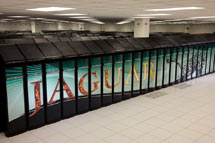
Handy Links
SLAC News Center
SLAC Today
- Subscribe
- Archives: Feb 2006-May 20, 2011
- Archives: May 23, 2011 and later
- Submit Feedback or Story Ideas
- About SLAC Today
SLAC News
Lab News
- Interactions
- Lightsources.org
- ILC NewsLine
- Int'l Science Grid This Week
- Fermilab Today
- Berkeley Lab News
- @brookhaven TODAY
- DOE Pulse
- CERN Courier
- DESY inForm
- US / LHC
SLAC Links
- Emergency
- Safety
- Policy Repository
- Site Entry Form

- Site Maps
- M & O Review
- Computing Status & Calendar
- SLAC Colloquium
- SLACspeak
- SLACspace
- SLAC Logo
- Café Menu
- Flea Market
- Web E-mail
- Marguerite Shuttle
- Discount Commuter Passes
-
Award Reporting Form
- SPIRES
- SciDoc
- Activity Groups
- Library
Stanford
Around the Bay
Simulating a More Efficient Linear Collider
Scientists around the world are working hard to hammer out a workable blueprint for the next big particle accelerator, the International Linear Collider, by 2012. A group at SLAC is doing its part, running supercomputer simulations to maximize the accelerator's performance and keep costs down on the proposed multi-billion-dollar collider.
The team, from SLAC's Advanced Computations Department, or ACD, is researching how to minimize the effects of charge "wakes" in the ILC, which will smash electrons and positrons into each other. As bunches of these particles race down accelerator tracks, electromagnetic wakes rise behind them. These wakefields can make the going rough for bunches to come, causing some particles to stray off course. As a result, beam quality can suffer and heat can build up inside accelerator cavities, potentially degrading their performance.
The more powerful the accelerator beam, the greater the potential wakefield effects. And the ILC's beam will be powerful, generating collision energies of about 500 billion electronvolts—ten times what SLAC's linac is capable of producing.
"Wakefields are an important issue for the ILC," said SLAC physicist Kwok Ko, head of ACD. "Controlling them is key."
To supplement planned wakefield experiments run on scaled-down ILC models—which are in the works at Fermilab—the SLAC team is running computer simulations. Such research, a marriage of physics and computational science, is what ACD does so well, and what makes the group unique. Other institutions have physicists and computational scientists on staff, but ACD, which was created in 2001, brings five researchers from each field together under one roof.
"ACD is the first department in the Department of Energy accelerator complex that has put together a team like this—physicists and computational scientists working together to solve big problems," Ko said.
Simulations of particle behavior in an accelerator, while much faster and cheaper than hardware experiments, are complicated endeavors. For one thing, they require specialized computer codes, which the SLAC group has been key in developing. From 2001 to 2005, Ko co-led a project, funded by the DOE's Scientific Discovery through Advanced Computing program, to hash some out. Two of his colleagues in ACD, Lie-Quan Lee and Cho Ng, are working on a current SciDAC project to improve upon the original algorithms and thus better tackle the ILC wakefield problem.
The wakefield work also demands a huge number-crunching capacity. In 2007, the DOE awarded the SLAC team an Innovative and Novel Computational Impact on Theory and Experiment grant. It was good for 4.5 million processor hours on Jaguar, a DOE supercomputer at Oak Ridge National Laboratory that can perform 1.64 quadrillion operations per second. This past December, the SLAC researchers got another INCITE grant, this one for eight million hours on Jaguar. They still have about 6.5 million hours left.
"We expect to use them all by the end of the year," said Lee, computational mathematics group leader in ACD.
As currently planned, the ILC will consist of two 14-kilometer-long linear accelerators facing each other. The basic unit of each accelerator is a meter-long cavity. Nine cavities make up one super-cooled, superconducting cryomodule, of which the ILC will contain about 3000. The SLAC scientists are unbowed by this scale and complexity.
"If you can understand one cryomodule, you have a better understanding of how the whole machine will work," said Ng, deputy department head of ACD.
And the researchers are well on their way to doing that. They have modeled wakefield effects throughout an entire cryomodule, finding that ILC designers can reduce wakefields considerably by providing enough damping. Absorbers between cryomodules—already part of ILC design—mean that wakefield effects across these accelerator components may not be a major factor.
Such findings could improve the collider's efficiency and make it more affordable. Building accelerator cavities will make up about 30 percent of the ILC's total price tag, according to the ILC's Global Design Effort. So improving the cavities even slightly—damping wakefield effects and thus reducing heating loads, for example—could minimize maintenance costs, leading to big savings.
"That was the motivation behind this simulation work," Lee said.
The team is confident that their simulations mirror reality. They benchmark all of their codes, comparing their results against experimental data and models employing other software packages. The researchers found their codes to be accurate within 0.01 percent. Further, their techniques are applicable to other particle accelerators, not just the ILC. Using the same codes, they recently performed a simulation for the Thomas Jefferson National Accelerator Facility in Virginia. The SLAC team's work showed that one cavity in a prototype cryomodule was eight millimeters shorter than it should have been—a measurement engineers confirmed when they looked at the actual machine. This fabrication error was identified as the cause of beam breakup in the cryomodule.
"We really can use simulation to solve a real-world problem," Ng said. "That's very exciting."
For more information about the SLAC team's ILC simulation work, see "Watching Wakefields to Keep Particles on Track."
—Michael Wall
SLAC Today, May 28, 2009

